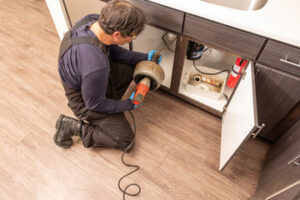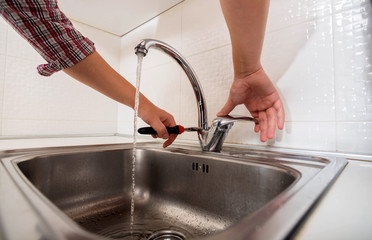
Understanding Your Plumbing Needs
Your plumbing is a complex network of pipes that brings water in and drains wastewater out. There are a wide variety of pipe sizes and materials. There are also special fittings to connect different kinds of pipes and to seal joints.
Codes may require that drain and vent pipes slant 1/8 inch per foot. This ensures that the pipes will drain properly. Read on or click here at https://www.platinumplumbingsbc.com/ for more information about plumbing.
 Water Supply
Water Supply
The water supply system transports water from the raw source to the people who use it. It is composed of a collection and distribution network and includes a variety of facilities, such as water treatment plants, reservoirs, and transmission lines. Water is often drawn from surface water sources, such as rivers or lakes; but it can also be obtained from groundwater sources such as aquifers. It is then treated, disinfected, and if necessary fluoridated before it is distributed to residential and commercial users.
Every home and property has a water supply line, which runs from the main water line to faucets and other home appliances. The water supply line has two paths – one for cold water and another for hot water. The latter path connects to the water heater and then leads to showers, kitchen faucets, and other appliances that need hot water.
Aside from supplying your home with clean and fresh water, the water supply line is also responsible for removing wastewater. Waste water is typically discharged in a sewage system, but it can be diverted to a garden or used for irrigation. A water supply system may also have water tanks to store excess water for emergencies.
Considering how important the water supply line is for your plumbing needs, you must know how to keep them functional. This knowledge will allow you to detect problems and deal with them competently.
The pipes that make up the supply line are made of various materials, including copper, brass, and plastics. Although they can withstand pressure, they are susceptible to leaks, corrosion, and even freeze damage since they are full of water regularly.
Drainage
Drainage is not only important for removing wastewater and extra water but also for preventing disease-carrying pathogens from breeding in wet areas. Proper drainage is crucial to healthy living, whether in a home or a community.
Water and waste products from plumbing fixtures drain into a system of pipes that transports them to the sewer system or septic tank for disposal. The piping conveys sewage without contaminating clean water or leaking into the environment. The piping is plumbed with a slope to help water flow freely, and each fixture has a drain line that collects used water and waste to keep the plumbing lines free of clogs.
A residential drainage system includes the main drain line that leads to the septic tank or municipal sewer line, and it has a vent pipe that keeps rainwater and other gases from entering the house. Each plumbing fixture has a drainpipe, and some have an additional trap to keep hair and other debris from clogging the line. Open drainage systems can cause flooding, soil erosion, and pollution, but closed drains are more hygienic and efficient than open ones.
Some of the most common forms of drainage include swales and ditches, which are designed to reduce floods, soil erosion, and pollution by allowing stormwater to percolate into the ground or be directed to a septic tank or drain system. They may feature surface gratings to allow rainwater or excess water to be collected, and they can be constructed from concrete, clay tile, or a polymer.
Other types of drainage include slot drains, which have a slim opening to prevent large sediment from clogging the drain without minimizing the rate at which water flows, and channel drainage, which intercepts water at gullies or other points and directs it to drainage pipes beneath the ground surface. They are typically made of concrete, steel, or polymer and require deep excavation.
Closed drainage systems form a complex network underground that collects primary refuse from individual areas, which is then transported to the local sewage treatment plant. Some homeowners choose to install drains in their yards to remove waste from toilets, tubs, and sinks. To prevent clogs, regularly empty the drains by flushing them with hot water or pouring drain cleaner. In addition to cleaning the drains, it’s important to check them for redness, swelling, warmth, or bad odors.
Fixtures
Plumbing fixtures are the devices that provide water service to a home. They include sinks, faucets, toilets, and showers. They also include a house septic system, which consists of a septic tank, a network of pipes that carry waste to and from the septic tank, and a venting system for noxious gasses.
Plumbers install and repair these fixtures and their accompanying pipes. They also install or replace the stop valves that control the flow of water to each fixture. These valves are usually located under kitchen and bathroom sinks, behind the toilet, in the basement, and the garage. It’s recommended that 1/2-inch supply lines be used for all fixtures except toilets, which require 3/8-inch lines. Drain and vent pipes must be of the proper size to prevent overflowing and back-pressure buildup.
Each fixture must have a drain with a trap to prevent sewer gases from entering living areas. The plumbing committee has a chart that shows the minimum size of drain pipe needed by several fixture units, as well as the size of the trap.
Additional Services
Plumbing services may include the installation of new pipes, drainage systems, and appliances. Plumbers can also perform routine maintenance tasks, such as clearing clogged drains and examining water meter readings to detect leaks. In the event of a plumbing emergency, like a burst pipe, they can turn off the water supply by turning off the main valve to prevent extensive damage.
Residential and commercial buildings rely on complex plumbing networks to deliver clean water and remove wastewater. This involves connecting household water pipes to public sewer lines, ensuring the safe and efficient transport of wastes.
Professional plumbers can install and repair these pipes, whether they’re made of PVC, copper, or steel. They can even recommend the best type of piping for different situations. For instance, PVC piping is suitable for most homes because it’s resistant to corrosion, durable and affordable. On the other hand, copper piping is ideal for kitchens and bathrooms because of its durability and timeless beauty.
While plumbing isn’t the most exciting occupation, it offers good job security and decent pay. Plus, it’s a necessary service that ensures we have safe and clean water for drinking and washing. If it weren’t for plumbers, we’d be at risk of contracting diseases from contaminated water and spending a fortune to fix sewage issues. So, while plumbing may not be the most glamorous profession, it’s an important one that saves lives. Just don’t expect to get rich from this career, since it requires manual skills that robots and computers can’t do.


